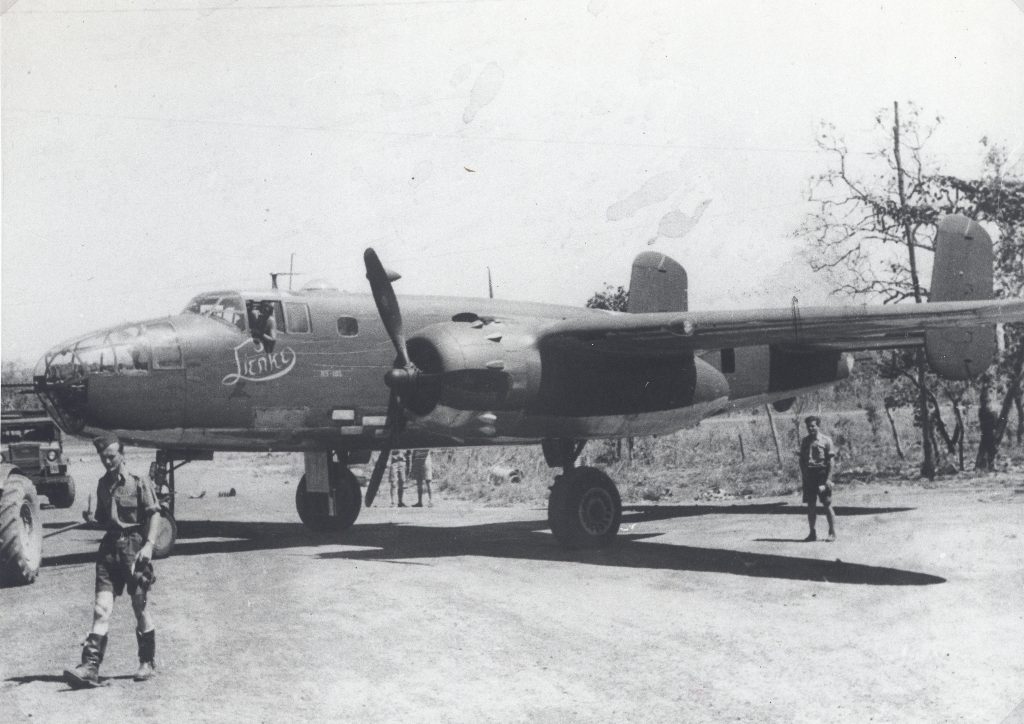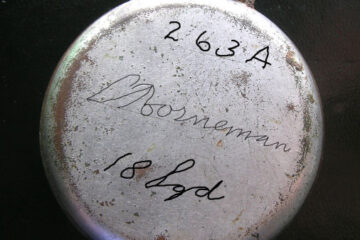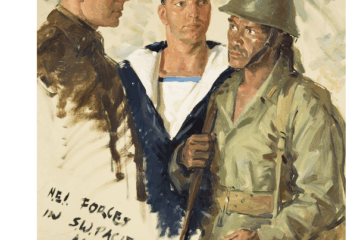Urgent need to replace aging planes – 162 new planes ordered
The Netherlands nor NEI and nor Australia for that matter were well prepared for war.
In NEI the ML-KNIL were using the no longer up-to-date Martin bombers (from the Glenn L. Martin Company in the USA). They were the first all-metal monoplane bombers. Rapid advances in bomber design in the late 1930s meant that these bombers, by the time WWII started, were superseded by the competition. The Martin 139-S used by the ML-KNIL in NEI could not carry enough armour and guns, nor did it have enough power to outrun the latest model fighter planes.
In June 1941, the decision was made by a desperate Dutch Government-in-Exile in London to purchase 162 B-25 Glen Mitchell bombers from the North American Aviation company to replace the Martin bombers. These new planes were in many ways superior; they could carry a payload of 1100 kg, had a reach of over 1900 km and could fly at 480 km per hour. They were to be delivered in the period from November 1942 to February 1943.
Urgent need for an earlier delivery – 60 extra planes ordered
However, because of the increasingly volatile war situation that delivery would not be in time and the Dutch Government negotiated an emergency allocation of extra planes.
The B-25 was a totally new type of plane and as other buyers took a wait-and-see-position in ordering them, the NEI was able to jump the queue and take delivery of extra bombers at reasonably short notice.
Sixty planes from a very large order of B-25 placed by the USAAF were set aside for the ML-KNIL. This batch could be delivered in early 1942. The decision was made to order these above the 162 B-25 bombers already ordered. Because of the urgency this had to be a cash sale which means it was fully paid for by the Dutch Government. The original order was still under production and that delivery was still planned to start later that year.
Planes to be delivered in British India and Australia
A ferry contract for the 60 planes (to fly the ordered planes from the USA to the destinations selected by the ML-KNIL) was signed. These planes were still supposed to be used for the war that was at that time already raging in the NEI. They would be flown to two destinations close to Java, British India and Australia.
The planning for the delivery of the first eight B-25 aircraft was: 8 in February 1942, 16 in March and 15 to 32 planes per month from April onwards. Twenty of the planes would be flown to British India via the South Atlantic route and ten via the Pacific route to Australia, where the ML-KNIL would take possession of them. Training would take place in Bangalore and Archerfield, before they would be flown to Java. The flights from the US required six refueling stops over a period of four to five days.
The B25 bombers were test-flown in Long Beach, California. From here they were flown to a Modification Centre in Memphis, Tennessee where the aircraft were brought up to date with the latest equipment. Finally, they were flown to Sacramento, California or West Palm Beach, Florida, from where they were to be ferried to the NEI.
NEI Depot Aircraft Division operation from Archerfield
In February 1942, a crew from the ML-KNIL was sent to Australia to receive the aircraft from the Americans. The largest group of NEI personnel left in four Lockheed Lodestars from Bandung. The detachment consisted of 43 people including Captain Boot, 18 pilots, 7 telegraphists and 14 mechanics. Three arrived at Archerfield Airport on 14 and 15 of February 1942.
En-route from Cloncurry to Archerfield, the third plane with Captain Boot onboard developed severe engine trouble on both engines and made an emergency landing in a meadow at Chinchilla Airport. The captain and four crew traveled by police car to Archerfield. The engines were repaired and a few days later the aircraft continued its flight to Archerfield.
Depot Aircraft Division (DVA) of the ML-KNIL was now formally established at Archerfield
The handover at Archerfield was thought to only require about a week per crew.
The plan therefor was still to fly the new B-25s from there to Java as soon as possible. The Government hoped they could still be used for the defense of NEI. By this time the Japanese had already invaded NEI (this had started on January 10) and the Japanese were now on their way to Java and the capital Batavia.
It soon became clear that the Dutch were fighting a losing battle and another ML-KNIL detachment departed from Java for Australia. This detachment, led by Major Roos, was tasked with setting up a permanent ML-KNIL organisation in Australia for the operation of the aircraft.
B-25 finally arriving in Archerfield
By late February 1942, several of the ordered aircraft were finally ready to be ferried from West Palm Beach, Florida. Two aircraft were damaged beyond repair at West Palm Beach and were not flown out.
The first three B-25 Mitchells – flown via the Pacific Route – finally arrived in Archerfield on 3 March, six days before the capitulation of NEI. Two arrived a day later and another one on 5 March.
Six planes were ferried along the South Atlantic Route to Bangalore. Eventually five reached Bangalore between 8 and 12 March 1942. One had crashed at Accra, Ghana on the way.
Regrouping after the capitulation of NEI
After the NEI had capitulated the remainder of the ferry flights were halted. The planes that were still in West Palm Beach were transferred back to Sacramento, California.
The five aircraft and ML-KNIL planes in Bangalore were transferred to the British RAF, which happened in April that year. No further planes for the ML-KNIL were sent to Bangalore. In April most of the Dutch staff was transferred to the ever-growing Dutch presence at Archerfield.
The NEI military in Archerfield were assisted by more personnel from the Depot Aircraft Division of the ML-KNIL, which had been able to move to Archerfield with Lodestar aircraft during the turmoil around the capitulation.
Enough NEI crew had now escaped to Australia enabling the Dutch to set up a new fighting squadron. As a result of this decision, the ferrying continued and a further 16 B-25 planes (part of the contract of 60 planes) arrived at Archerfield between 18 and 29 March. Some of the aircraft that arrived after April 7 were redirected to Amberley as Archerfield had become too busy. The airport had now also become the refueling station for air transport from Sydney and Melbourne to New Guinea and Darwin.
Crew’s family stranded in NEI
| The rapid invasion of NEI by the Japanese saw the Dutch crew, stuck in Australia, while their families were left behind in Java, now under Japanese occupation. Many wives and children ended up in the notorious Japanese concentration camps.Three of the NEI pilots in Archerfield were later accused of desertion as they had been planning to go back to NEI to try and bring their families to safety. |
With the urgent need of airplanes, it was decided – as was the case with the above mentioned civil KNILM planes – to sell eleven of the Lockheed aircraft to the Allied Directorate of Air Transport they were later transferred to the USAAF.
Several mishaps in and around Archerfield
| Training of the NEI pilots and technical staff started on 6 March. Just over two weeks later most of the crew was trained and ready for operation. However, there were several mishaps and accidents which happened mainly with some of the ferry pilots during that initial period: · Two planes were damaged during a landing exercise. · One hit another B-25 parked on the ground. · On landing a parked Douglas DC-3 was damaged and the plane shot through the fence and crashed into a house. · A fourth one damaged its landing gear during takeoff. · One skidded on the grass runway during wet weather and rolled. · Finally, one had engine failure and landed in the trees outside the airfield. In the end two B-25 planes were written off. One plane with factory problems was used for spare parts and the other damaged planes were eventually repaired, Because of the slippery grass surface at Archerfield two other planes from the USA were directed to Amberley where there was a hard surface runway. |
Detachment ML-KNIL Archerfield
Later 24 more B-25s arrived from the USA. The by now 50 men strong group of ML- KNIL personnel became known as Detachment Archerfield.
Finally in March 1942, the USAAF withdrew the priority assignment of the B-25s to the ML-KNIL and instead decided that:
- 18 aircraft were to stay or to go to the ML-KNIL in Australia;
- 24 were to go to General MacArthur for the USAAF in Australia;
- 5 were transferred to the RAF in India;
- 6 were retained by the USAAF for delivery to Brazil; and
- 4, still at the Memphis Modification Centre and were retained by the USAAF.
This accounts for 57 aircraft – three others had been written off.
Twelve of the planes allocated to General MacArthur were taken over by Lieutenant-General George Brett who became the Commanding-General of the Allied Air Forces in the South West Pacific Area. These planes were urgently needed for the 3 Bombardment Group of the USAAF, because its crew had arrived at Archerfield – but without aircraft.
The 18 Netherlands East Indies Squadron
It was the intention of the commander of the ML-KNIL General van Oyen to establish a NEI Squadron using the various aircraft and air crew who were now at Archerfield this included Dutch technical personnel who had been able to evacuate to Australia. Collaboration with the RAAF led to the formation of a combined squadron.
The 80 ML-KNIL members from Archerfield together with members of the RAAF now formed the 18 Netherlands East Indies Squadron. These airmen were divided into several operational groups under RAAF control. All their stores and equipment were supplied by the American Armed Forces.
A few months later under a similar arrangement between the Dutch and Australian military command a second squadron was installed, named 12 Squadron. This squadron moved from Archerfield to Merauke in the southern part of Dutch New Guinea – the only unoccupied territory in NEI.
As the busy Archerfield airfield was not suitable for the training of the Dutch crews, the 18 Squadron was transferred to Canberra, in April 1942.
Captain Boot received the boot
| General van Oyen wanted to make Captain Boot provisional squadron commander until the whole squadron would reach operational strength.However, Boot was very unpopular among his staff. They accused him of ill treatment and a lack of respect, this nearly led to a revolt under the NEI crew.General van Oyen decided to instead appoint Major B.J. Fiedeldij to take over the command. Boot apparently did change his behaviour and returned at the Squadron as an Operations Officer and became a highly decorated pilot at the 18 Squadron. |
After their training in Canberra, the 18th became operational and was moved to McDonald Airfield near Darwin. This was closer to the battlefield. The squadron was now brought to full strength with the arrival of more RAAF personnel and consisted of 40 officers and 210 men from the ML-KNIL and 8 officers and 300 men from the RAAF.
They were involved in many actions across NEI and were operational until 1950, when the equipment from the squadron was handed over to the Indonesian Airforce.
The Forgotten Story
 Lienke’ the B-25 Mitchell flown by Gerson Hagers of the 18 Squadron NEI at Potshot WWII airport in WA. The plane is named after his wife, who he had to leave behind in Java. Source: Nederlands Instituut voor Militaire Historie.One of the greatest pilots of the Squadron was Gerson Hagers. He was also one of the original pilots who was stuck at Archerfield and could not bring his wife Lienke to safety. Unknowingly to him she ended up in a Japanese Camp.He wrote a war diary that also details the revolt against Boot, the drama with his colleagues who wanted to fly to NEI to pick up their family and the politics of the NEI Government and military, the latter was often not very flattering. A novel has been written based on this period of his life titled: Het Vergeten Verhaal (The Forgotten Story). Gerson had never really been able to re-adjust to life after his after his demobilisation. He emigrated to the United States where he found work as a ‘crop spray pilot’. In 1952, he died in Oregon in an air crash while at work. Lienke wrote her own memories which have also been included in the book. She later remarried and lived in California as Linda Duncan-Buriks. Lienke’ the B-25 Mitchell flown by Gerson Hagers of the 18 Squadron NEI at Potshot WWII airport in WA. The plane is named after his wife, who he had to leave behind in Java. Source: Nederlands Instituut voor Militaire Historie.One of the greatest pilots of the Squadron was Gerson Hagers. He was also one of the original pilots who was stuck at Archerfield and could not bring his wife Lienke to safety. Unknowingly to him she ended up in a Japanese Camp.He wrote a war diary that also details the revolt against Boot, the drama with his colleagues who wanted to fly to NEI to pick up their family and the politics of the NEI Government and military, the latter was often not very flattering. A novel has been written based on this period of his life titled: Het Vergeten Verhaal (The Forgotten Story). Gerson had never really been able to re-adjust to life after his after his demobilisation. He emigrated to the United States where he found work as a ‘crop spray pilot’. In 1952, he died in Oregon in an air crash while at work. Lienke wrote her own memories which have also been included in the book. She later remarried and lived in California as Linda Duncan-Buriks. |
This ends the story of the B25s and that of the formation of the 18 Squadron until their departure from Archerfield. The plan was to establish a second NEI squadron, however, because of staff shortage this didn’t happen. In December the 120 NEI Squadron RAAF was formed in Canberra.


